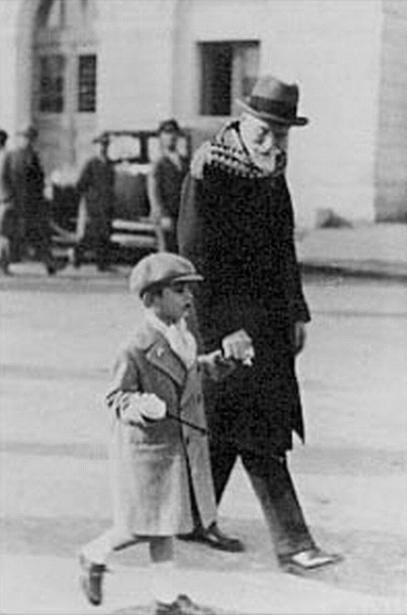
Greek Boys Clothes Chronology: The 1930s

Figure 1.--Prime Minister Venizelos and his grandson were photographed in Athens during the early 1930s. The boy wears a stylish peaked cap and overcoat with short pants and white ankle socks. Note the cane. Venizelos was gthe major figure supporting the Republic.
|
|
Greece's political instability of the 1920s continued into the 1930s. It was a standoff between repubublicans and monarchists. The 1930s is often mockingly called the 'belle epoque', in part because there was no war. The economy as in the rest of Europe was adversely affected affected by the Great Depression (1929). The world-wide Depression hit Greece especially hard. Greece even before the Depression was a poor country dependent on agricultural exports. Importers erected trade barriers. And the United States even before the Drepression began limiting immigration. This was a traditional safety valve of rural poverty in Europe, including Greece. Rising unemployment fuled social unrest and the Communist Partyvsuccess at the polls. The Venizelos Government defaulted on the national debt (1932). Eventually Ioannis Metaxas, a royalist officer, seized power and installed a Fasist style regime. It never achieved the mass support of the more famous Fascist regimes Germany and Italy) and would evemtually be invaded by Fascist Italy (1940). Despite the economic situation, we note quite a few portraists of well-to-do children in the cities. Sailor suits were still worn, but not as much as in earlier years. Boys from affluent families were dressed in the latest fashions, often looking rather like a well dressed boys in England or France. The styles were a littlore casuaal. Boys wore suits, but given the warm climate, lighter fabrics with a somewhat more casual look. The poverty that still affected Greece, however, meant that many boys at this time could not dress very well, especially boys in rural mares. Uniforms were very popular with boys, both Scout uniforms and the uniforms of Metaxas' new EON youth movement which was active in the 1930s. Most Greek boys in the 1930s commonly wore short pants, especially in the warm summer months. Knee socks were not as common as in the more northerly European countries. Many boys wore sandals or went barefoot.
Instability and Economic Problems
Greece's political instability of the 1920s continued into the 1930s. It was a standoff between republicans and monarchists. The 1930s is often mockingly called the 'belle epoque', in part because there was no war. The economy as in the rest of Europe was adversely affected affected by the Great Depression (1929). The world-wide Depression hit Greece especially hard. Greece even before the Depression was a poor country dependent on agricultural exports. Importers erected trade barriers. And the United States even before the Drepression began limiting immigration. This was a traditional safety valve of rural poverty in Europe, including Greece. Rising unemployment fuled social unrest and the Communist Partyvsuccess at the polls. The Venizelos Government defaulted on the national debt (1932). Eventually Ioannis Metaxas, a royalist officer, seized power and installed a Fasist style regime. It never achieved the mass support of the more famous Fascist regimes Germany and Italy) and would evemtually be invaded by Fascist Italy (1940).
Despite the economic situation, we note quite a few portraists of well-to-do childen in the cities. Studio portraits, however, unlike snapshots provide no demographic information neyond the clothing. Sailor suits were still worn, but not as much as in earlier years. Boys from affluent families were dressed in the latest fashions, often looking rather like a well dressed boys in England or France. The styles were a little more casual. Boys wore suits, but given the warm climate, lighter fabrics with a somewhay more casual look. Here the photographic ecord can be misleading. Families that bhad the money for studio portaits tended to be the better off, meaning they also had the ability to dress well.
Rural Poverty
The poverty that still affected Greece, however, meant that many boys at this time could not dress very well, especially boys in rural arees.
Garments
Most Greek boys in the 1930s commonly wore short pants, especially in the warm summer months. Knee socks were not as common as in the more northerly European countries. Many boys wore sandals or went barefoot.
Youth Groups
Uniforms were very popular with boys, both Scout uniforms and the uniforms of Metaxas' new EON youth movement which was active in the 1930s.
HBC

Navigate the Boys' Historical Clothing Web Site:
[About Us]
[Introduction]
[Activities]
[Biographies]
[Chronology]
[Clothing styles]
[Countries]
[Girls]
[Theatricals]
[Topics]
[Bibliographies]
[Contributions]
[FAQs]
[Glossaries]
[Images]
[Links]
[Registration]
[Tools]
[Boys' Clothing Home]
Navigate the Boys' Historical Clothing Greek pages:
[Return to the Main Greek 20th century chronology page]
[Greek choirs]
[Greek folk costumes]
[Greek movies]
[Greek royals]
[Greek schools]
[Greek youth groups]
Created: June 7, 2002
Last updated: 9:30 PM 3/22/2019



